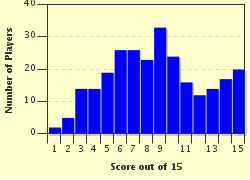Quiz Answer Key and Fun Facts
1. What was the name of the horse ridden by Robert E. Lee during the American Civil War, aka the War Between the States?
2. Who rode a horse named Copenhagen?
3. Which King of England died as a result of being thrown when his horse Sorrel stumbled into a mole hill?
4. Give me the name of the man who rode Black Bess on a famous journey from London to York?
5. According to Roman historian Suetonius this horse almost became a Roman Consul, but his master died before he could make the appointment.
6. One of the most famous rides ever was on the back of a borrowed horse named Brown Beauty. Who was in the saddle?
7. According to Shakespeare, who is supposed to have cried out "A horse! A horse! My kingdom for a horse!" at a battle that changed the course of English history?
8. Who paid the bills for the oats and hay consumed by a horse named Burmese?
9. Who rode into movie history on a horse named Tony?
10. Who rode Babieca into battle?
11. This horse, owned and ridden by Canadian Ian Millar, was the first ever to win two Show Jumping World Cup Championships back to back.
12. This horse, Napoleon's favourite mount, was named for one of Bonaparte's great victories.
13. This horse was the only documented survivor of Custer's last stand at the Battle of the Little Big Horn (known to the indigenous people of North America as Greasy Grass because of the amount of blood spilled!) His original Lakota name was Tonka. What had the Seventh Cavalry named him?
14. Who rode a horse named Magnolia?
15. Let's wind up this quiz with a really easy question. What was the name of Trigger's stable mate, ridden by Dale Evans?
Source: Author
Cymruambyth
This quiz was reviewed by FunTrivia editor
bloomsby before going online.
Any errors found in FunTrivia content are routinely corrected through our feedback system.

